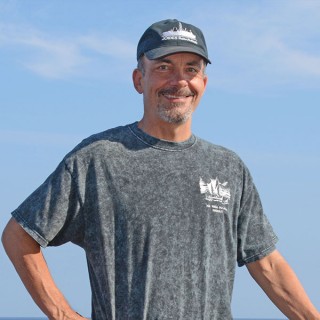Find out where Falkor is during her mapping of Tamu Massif from Chief Scientist William Sager.
10/29/15
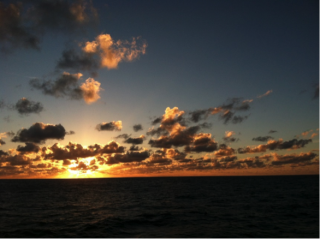
We are nearing the home stretch and can see the light at the end of the tunnel. The weather is fine right now and the forecast looks good for the next several days. We are enjoying the sunshine and relative stability. The skies are looking clear, so tonight we will turn out the deck lights on the fantail and have a look at the stars. Leighton our Lead Marine Technician will give a tour of the sky and I will help out. This Saturday, I will also plan to give a science lecture in the library about the magnetics. Keep on mapping.
10/27/15
I’m sure you noticed the nice weather, sunshine through the portholes, and the fact that we are back on our survey track. For the moment, all’s right with the cruise. Current weather predictions are good for the survey to continue, however, we will get a weak low off of Japan, so we may have some wind and waves, but we are not anticipating having to break off from the survey. So we will continue surveying eastward. The captain says that our arrival in Guam is still scheduled for 10 November. The data are looking great. Keep up the good work and enjoy the sunshine.
10/24/15
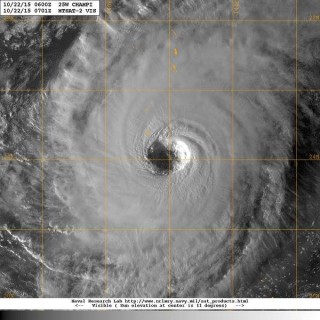 The remnants of Typhoon Champi are passing to the south, however, there is a monster low in the far north Pacific that is strengthening. That low sets up strong winds in our neighborhood for the next few days. We will continue to move southwest away from the higher seas. Our conditions will be about the same with potentially a bit more seas building because of the sustained strong winds. It looks like we will have to wait until Tuesday or Wednesday to go back to surveying. By that time, we will be on the west side of the survey, so the plan is to begin surveying at the west end of the proposed survey and work our way back to the middle. I doubt that we will have time to finish all of the survey lines, so this will leave a gap in the middle. The far western lines are more important than those in the middle because the western “tail” of Tamu Massif has not seen much data collection. Besides, the weather will improve from west to east, so that is the first spot where we can begin again.
The remnants of Typhoon Champi are passing to the south, however, there is a monster low in the far north Pacific that is strengthening. That low sets up strong winds in our neighborhood for the next few days. We will continue to move southwest away from the higher seas. Our conditions will be about the same with potentially a bit more seas building because of the sustained strong winds. It looks like we will have to wait until Tuesday or Wednesday to go back to surveying. By that time, we will be on the west side of the survey, so the plan is to begin surveying at the west end of the proposed survey and work our way back to the middle. I doubt that we will have time to finish all of the survey lines, so this will leave a gap in the middle. The far western lines are more important than those in the middle because the western “tail” of Tamu Massif has not seen much data collection. Besides, the weather will improve from west to east, so that is the first spot where we can begin again.
Although the maggie is on board, we are still collecting multi beam bathymetry data. Any place where we can collect data is imporant and valuable. We will continue watches because we need to keep an eye on the MB and keep an up-to-date log. That log is very valuable because you cant always remember once the cruise is done. You are keeping that log for our future research and for others who would use our data in the future (so it’s important). The good news about the weather is that after we clear out this stormy weather, it looks like the weather should be good for a while.
10/22/15
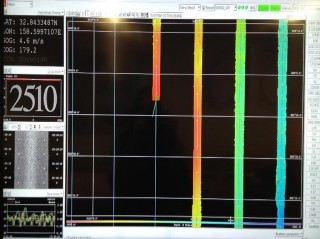
The weather situation is going as expected. Last night a little low developed on the east side of Champi and it is still projected to head towards Tamu Massif. We will finish Line 7 this afternoon and turn north on Line 8, which we will finish a bit over 24 hours later. The captain wants to be north when Champi comes by, so we will probably head west from the north end of Line 8 and slow down until Champi goes by. We may tow the magnetometer on this diversion – or not – depending on the captain’s reading of conditions when we get there. After a day or so of the diversion, the plan is to come south again and pick up the survey at the west end, working back toward the middle. Current weather forecasts have a high pressure system building over the survey area after Champi goes by. That means good weather. Today is “hump day”. We are half way done and over the hump. It is all downhill from here. Keep up the good work!
10/20/15

We just met with the captain and crew of Falkor to discuss the current weather, and possibility of Typhoon Champi heading in our direction. The forecast is looking good for another three days and the remnants of Typhoon Champi is weakening, however, the storm is still headed towards Tamu Massif and may arrive four to five days from now. The good news is that the forecast predicts a rapid passage. That said, weather forecasts in the middle of the ocean are difficult because there are few meteorological data points to model. Although weakened, safety is the first priority and we may need to take a break from mapping to avoid the storm. The current plan is to run line 6 (north), line 7 (south), and line 8 (north), which will have us in the northern part of the study area around four and a half days from now. Right now, the captain thinks we should break off the survey for a couple of days and go west, around the storm, and then come back into the survey area once it passes.
On the science end, we are getting great data and nearing the half-way point. We also continue to make strides with the latest outreach and have made 31 ship-to-shore connections, reaching over 900 students ranging from fifth grade through to university.
10/15/15
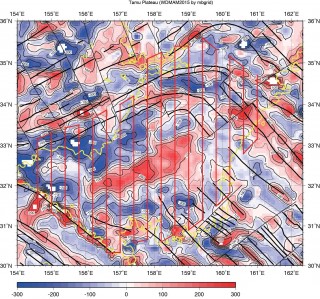
The internet went out last night when we turned onto our first trackline. There was uncomfortable speculation that the course was one in which the stacks were blocking the internet signal, but fortunately, that does not seem to be the case. I spent about an hour worrying about the tracklines. Could I shift them to a better course? Was this a problem for the science? Would we spend half the cruise blacked out and with the outreach in disarray? Thankfully, no- the internet antennas are not blocked.
But this brings up an interesting question. Just why are we going on these particular North-South tracks? The bathymetry plot doesn’t show anything that dictates the direction. The magnetic plot does. We want to cut across the magnetic lineations (black line on the mag plot) at the edges of Tamu Massif with oblique angles. If we run along the trend of a magnetic anomaly we don’t “see it”. The North-South direction cuts across the SW-NE anomalies on the west side, the NW-SE anomalies on the SW side, and the curved anomalies on the North side at good angles. There is no other single orientation that does this. We would have had to survey part of the volcano in one direction and the other part in another direction if we had to change the plan. Also, we want to start on the east side and finish on the west side because the latter is closer to Guam. If anybody wonders, these constraints are the rationale for our survey.
So far, so good. The weather is beautiful right now – almost glassy. I wish we could order this up for the next few weeks. But typhoon Champi may have something to say about that in a few days!
10/09/15
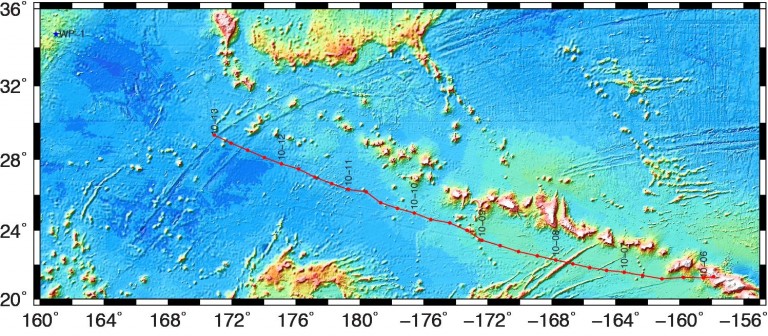 We have transited 1837km (991NM) with an average speed of 10.68kts.
We have transited 1837km (991NM) with an average speed of 10.68kts.
The team has been mapping for 91:30 hours and pinged 38,754 times with the total number of soundings 16,741,728. We have produced roughly 11,489.5755 Km2 (An area the size of Gambia).
The maximum depth recorded by the system is 6482m and the average depth is 4203m. our average swath width is 4853m
Ship to Shore Connections: 148 students and adults from Texas and California today.
For up-to-date tracking please visit the Falkor Status Page.
